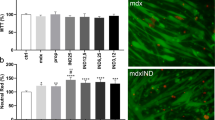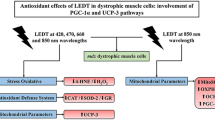Abstract
Increased oxidative stress is a frequent feature in Duchenne muscular dystrophy (DMD). High reactive oxygen species (ROS) levels, associated with altered enzyme antioxidant activity, have been reported in dystrophic patients and mdx mice, an experimental model of DMD. In this study, we investigated the effects of coenzyme Q10 (CoQ10) on oxidative stress marker levels and calcium concentration in primary cultures of dystrophic muscle cells from mdx mice. Primary cultures of skeletal muscle cells from C57BL/10 and mdx mice were treated with coenzyme Q10 (5 μM) for 24 h. The untreated mdx and C57BL/10 muscle cells were used as controls. The MTT and live/dead cell assays showed that CoQ10 presented no cytotoxic effect on normal and dystrophic muscle cells. Intracellular calcium concentration, H2O2 production, 4-HNE, and SOD-2 levels were higher in mdx muscle cells. No significant difference in the catalase, GPx, and Gr levels was found between experimental groups. This study demonstrated that CoQ10 treatment was able to reduce levels of oxidative stress markers, such as H2O2, acting as an antioxidant, as well as decreasing abnormal intracellular calcium influx in dystrophic muscles cells. This study demonstrated that CoQ10 treatment was able to reduce levels of oxidative stress markers, such as H2O2, acting as an antioxidant, as well as decreasing abnormal intracellular calcium influx in dystrophic muscles cells. Our findings also suggest that the decrease of oxidative stress reduces the need for upregulation of antioxidant pathways, such as SOD and GSH.





Similar content being viewed by others
References
Acosta MJ, Fonseca LV, Desbats MA, Cerqua C, Zordan R, Trevisson E et al (2016) Coenzyme Q biosynthesis in health and disease. Biochim Biophys Acta 1857:1079–1085. https://doi.org/10.1016/j.bbabio.2016.03.036
Adrews JG, Wahl R (2018) Duchenne and Becker muscular dystrophy in adolescents: current perspectives. Adolesc Health Med Ther 9:53. https://doi.org/10.2147/AHMT.S125739
Allen DG, Gervasio OL, Yeung EW, Whitehead NP (2010) Calcium and the damage pathways in muscular dystrophy. Can J Physiol Pharmacol 88:83–91. https://doi.org/10.1139/Y09-058
Altamirano F, Valladares D, Henriquez-Olguin C, Casas M, Lopez JR, Allen PD, Jaimovich E (2013) Nifedipine treatment reduces resting calcium concentration, oxidative and apoptotic gene expression, and improves muscle function in dystrophic mdx mice. PLoS One 8:e81222. https://doi.org/10.1371/journal.pone.0081222
Anderson ME (1985) Determination of glutathione and glutathione disulfide in biological samples. Methods Enzymol 113:548–555
Anderson JE, Wozniak AC (2004) Satellite cell activation on fibers: modeling events in vivo-an invited review. Can J Physiol Pharmacol 82:300–310. https://doi.org/10.1139/y04-020
Bahar M, Khaghani S, Pasalar P, Paknejad M, Khorramizadeh MR, Mirmiranpour H et al (2010) Exogenous coenzyme Q10 modulates MMP-2 activity in MCF-7 cell line as a breast cancer cellular model. Nutr J 9:62. https://doi.org/10.1186/1475-2891-9-62
Baker F, Vandebrouck C, Gailly P, Gillis JM (2002) Long-term study of Ca2+ homeostasis and of survival in collagenase-isolated muscle fibres from normal and mdx mice. J Physiol 542:855–865. https://doi.org/10.1113/jphysiol.2002.020487
Balaban B, Matthews DJ, Clayton GH, Carry T (2005) Corticosteroid treatment and functional improvement in Duchenne muscular dystrophy: long-term effect. Am J Phys Med Rehabil 84:843–850. https://doi.org/10.1097/01.phm.0000184156.98671.d0
Bentinger M, Tekle M, Dallner G (2010) Coenzyme Q–biosynthesis and functions. Biochem Biophys Res Commun 396:74–79. https://doi.org/10.1016/j.bbrc.2010.02.147
Briston T, Roberts M, Lewis S, Powney B, Staddon J, Szabadkai G et al (2017) Mitochondrial permeability transition pore: sensitivity to opening and mechanistic dependence on substrate availability. Sci Rep 7:10492. https://doi.org/10.1038/s41598-017-10673-8
Bulfield G, Siller WG, Wight PA, Moore KJ (1984) X chromosome-linked muscular dystrophy (mdx) in the mouse. Proc Natl Acad Sci U S A 81(4):1189–1192
Busanello ENB, Marques AC, Lander N, de Oliveira DN, Catharino RR, Oliveira HCF, Vercesi AE (2017) Pravastatin chronic treatment sensitizes hypercholesterolemic mice muscle to mitochondrial permeability transition: protection by creatine or coenzyme Q(10). Front Pharmacol 8:185. https://doi.org/10.3389/fphar.2017.00185
Bushby K, Finkel R, Birnkrant DJ, Case LE, Clemens PR, Cripe L et al (2010) Diagnosis and management of Duchenne muscular dystrophy, part 1: diagnosis, and pharmacological and psychosocial management. Lancet Neurol 9:77–93
Devun F, Walter L, Belliere J, Cottet-Rousselle C, Leverve X, Fontaine E (2010) Ubiquinone analogs: a mitochondrial permeability transition pore-dependent pathway to selective cell death. PLoS One 5:e11792. https://doi.org/10.1371/journal.pone.0011792
Disatnik MH, Dhawan J, Yu Y, Beal MF, Whirl MM, Franco AA et al (1998) Evidence of oxidative stress in mdx mouse muscle: studies of the pre-necrotic state. J Neurol Sci 161:77–84. https://doi.org/10.1016/S0022-510X(98)00258-5
Długosz A, Kuźniar J, Sawicka E, Marchewka Z, Lembas-Bogaczyk J, Sajewicz W et al (2004) Oxidative stress and coenzyme Q 10 supplementation in renal transplant recipients. Int Urol Nephrol 36:253–258. https://doi.org/10.1023/B:UROL.0000034652.88578.a8
Duchen MR, Verkhratsky A, Muallem S (2008) Mitochondria and calcium in health and disease. Cell Calcium 44:1–5. https://doi.org/10.1016/j.ceca.2008.02.001
Ervasti JM, Sonnemann KJ (2008) Biology of the striated muscle dystrophin–glycoprotein complex. Int Rev Cytol 265:191–225. https://doi.org/10.1016/S0074-7696(07)65005-0
Flint Beal M (2002) Coenzyme Q 10 as a possible treatment for neurodegenerative diseases. Free Radic Res 36:455–460. https://doi.org/10.1080/10715760290021315
Fontaine E, Ichas F, Bernardi P (1998) A ubiquinone-binding site regulates the mitochondrial permeability transition pore. J Biol Chem 273:25734–25740. https://doi.org/10.1074/jbc.273.40.25734
Fouad AA, Al-Sultan Al, Refaie SM, Yacoubi MT (2010) Coenzyme Q10 treatment amelioretes acute cisplatin nephrotoxicity in mice. Toxicology 274, 49–56.
Gomes P, Simao S, Silva E, Pinto V, Amaral JS, Afonso J et al (2009) Aging increases oxidative stress and renal expression of oxidant and antioxidant enzymes that are associated with an increased trend in systolic blood pressure. Oxidative Med Cell Longev 2:138–145
Guatimosim S, Guatimosim C, Song LS (2011) Imaging calcium sparks in cardiac myocytes. Methods Mol Biol 689:205–214. https://doi.org/10.1007/978-1-60761-950-5_12
Guescini M, Tiano L, Genova ML, Polidori E, Silvestri S, Orlando P et al (2017, 2017) The combination of physical exercise with muscle-directed antioxidants to counteract sarcopenia: a biomedical rationale for pleiotropic treatment with creatine and coenzyme Q10. Oxidative Med Cell Longev. https://doi.org/10.1155/2017/7083049
Guiraud S, Davies KE (2017) Pharmacological advances for treatment in Duchenne muscular dystrophy. Curr Opin Pharmacol 34:36–48. https://doi.org/10.1016/j.coph.2017.04.002
Hernandez-Camacho JD, Bernier M, Lopez-Lluch G, Navas P (2018) Coenzyme Q10 supplementation in aging and disease. Front Physiol 9:44. https://doi.org/10.3389/fphys.2018.00044
Ishrat T, Khan MB, Hoda MN, Yousuf S, Ahmad M, Ansari MA et al (2006) Coenzyme Q10 modulates cognitive impairment against intracerebroventricular injection of streptozotocin in rats. Behav Brain Res 171:9–16. https://doi.org/10.1016/j.bbr.2006.03.009
Kagan V, Serbinova E, Packer L (1990) Antioxidant effects of ubiquinones in microssomes and mitochondria are mediated by tocopherol recycling. Biochem Biophys Res Commun 169(3):851–857
Kamdar F, Garry DJ (2016) Dystrophin-deficient cardiomyopathy. J Am Coll Cardiol 67:2533–2546. https://doi.org/10.1016/j.jacc.2016.02.081
Kowaltowski AJ, Castilho RF, Vercesi AE (2001) Mitochondrial permeability transition and oxidative stress. FEBS Lett 495:12–15. https://doi.org/10.1016/S0014-5793(01)02316-X
Lee BJ, Lin YC, Huang YC, Ko YW, Hsia S, Lin PT (2012) The relationship between coenzyme Q10, oxidative stress, and antioxidant enzymes activities and coronary artery disease. Sci World J. https://doi.org/10.1100/2012/792756
Lekli I, Das S, Das S, Mukherjee S, Bak I, Juhasz B et al (2008) Coenzyme Q9 provides cardioprotection after converting into coenzyme Q10. J Agric Food Chem 56:5331–5337. https://doi.org/10.1021/jf800035f
Liguori I, Russo G, Curcio F, Bulli G, Aran L, Della-Morte D et al (2018) Oxidative stress, aging, and diseases. Clin Interv Aging 13:757. https://doi.org/10.2147/CIA.S158513
Littarru GP, Tiano L (2007) Bioenergetic and antioxidant properties of coenzyme Q 10: recent developments. Mol Biotechnol 37:31–37. https://doi.org/10.1007/s12033-007-0052-y
Loehr JA, Stinnett GR, Hernandez-Rivera M, Roten WT, Wilson LJ, Pautler RG et al (2016) Eliminating Nox2 reactive oxygen species production protects dystrophic skeletal muscle from pathological calcium influx assessed in vivo by manganese-enhanced magnetic resonance imaging. J Physiol 594:6395–6405. https://doi.org/10.1113/JP272907
Macedo AB, Moraes LHR, Mizobuti DS, Fogaca AR, Moraes FDSR, de Almeida Hermes T et al (2015) Low-level laser therapy (LLLT) in dystrophin-deficient muscle cells: effects on regeneration capacity, inflammation response and oxidative stress. PLoS One 10:e0128567. https://doi.org/10.1371/journal.pone.0128567
Maraver JG, Cordero MD, Ávila MO, Vega AF, Mata M, Pavón A et al (2014) Coenzyme Q10 therapy. Mol Syndromol 5:187–110
Marques AC, Busanello ENB, de Oliveira DN, Catharino RR, Oliveira HCF, Vercesi AE (2018) Coenzyme Q10 or creatine counteract pravastatin-induced liver redox changes in hypercholesterolemic Mice. Front Pharmacol 9:685. https://doi.org/10.3389/fphar.2018.00685
Pal R, Palmieri M, Loehr JA, Li S, Abo-Zahrah R, Monroe TO, Thakur PB, Sardiello M, Rodney GG (2014) Src dependent impairment of autophagy by oxidative stress in a mouse model of Duchenne muscular dystrophy. Nat Commun 5:4425–4410. https://doi.org/10.1038/ncomms5425
Rando TA, Blau HM (1994) Primary mouse myoblast purification, characterization, and transplantation for cell-mediated gene therapy. J Cell Biol 125:1275–1287. https://doi.org/10.1083/jcb.125.6.1275
Robinson-Hamm JN, Gersbach CA (2016) Gene therapies that restore dystrophin expression for the treatment of Duchenne muscular dystrophy. Hum Genet 135:1029–1040. https://doi.org/10.1007/s00439-016-1725-z
Ryder S, Leadley R, Armstrong N, Westwood M, de Kock S, Butt T et al (2017) The burden, epidemiology, costs and treatment for Duchenne muscular dystrophy: an evidence review. Orphanet J Rare Dis 12:79. https://doi.org/10.1186/s13023-017-0631-3
Sanoobar M, Eghtesadi S, Azimi A, Khalili M, Jazayeri S, Reza Gohari M (2013) Coenzyme Q10 supplementation reduces oxidative stress and increases antioxidant enzyme activity in patients with relapsing–remitting multiple sclerosis. Int J Neurosci 123:776–782. https://doi.org/10.3109/00207454.2013.801844
Shkryl VM, Martins AS, Ullrich N, Nowycky MC, Niggli E, Shirokova N (2009) Reciprocal amplification of ROS and Ca2+ signals in stressed mdx dystrophic skeletal muscle fibers. Pflugers Arch 458(5):915–928. https://doi.org/10.1007/s00424-009-0670-2
Sies H (2015) Oxidative stress: a concept in redox biology and medicine. Redox Biol 4:180–183. https://doi.org/10.1016/j.redox.2015.01.002
Smith AST, Davis J, Lee G, Mack DL, Kim DH (2016) Muscular dystrophy in a dish: engineered human skeletal muscle mimetics for disease modeling and drug discovery. Drug Discov Today 21:1387–1398. https://doi.org/10.1016/j.drudis.2016.04.013
Sugiyama S, Kitazawa M, Ozawa T, Suzuki K, Izawa Y (1980) Anti-oxidative effect of coenzyme Q10. Experentia 36:1002–1003
Tarry-Adkins JL, Joles JA, Chen JH, Martin-Gronert MS, Van der Giezen DM, Goldschmeding R et al (2007) Protein restriction in lactation confers nephroprotective effects in the male rat and is associated with increased antioxidant expression. Am J Physiol Regul Integr Comp Physiol 293:R1259–R1266. https://doi.org/10.1152/ajpregu.00231.2007
Tutdibi O, Brinkmeier H, Rudel R, Fohr K (1999) Increased calcium entry into dystrophin-deficient muscle fibres of MDX and ADR-MDX mice is reduced by ion channel blockers. J Physiol 515:859–868. https://doi.org/10.1111/j.1469-7793.1999.859ab.x
Whitehead NP, Yeung EW, Allen DG (2006) Muscle damage in mdx (dystrophic) mice: role of calcium and reactive oxygen species. Clin Exp Pharmacol Physiol 33:657–662. https://doi.org/10.1111/j.1440-1681.2006.04394.x
Whitehead NP, Yeung EW, Froehner SC, Allen DG (2010) Skeletal muscle NADPH oxidase is increased and triggers stretch-induced damage in the mdx mouse. PLoS One 5:e15354. https://doi.org/10.1371/journal.pone.0015354
Wu B, Shah SN, Lu P, Richardson SM, Bollinger LE, Blaeser A et al (2016) Glucocorticoid steroid and alendronate treatment alleviates dystrophic phenotype with enhanced functional glycosylation of α-dystroglycan in mouse model of limb-girdle muscular dystrophy with FKRPP448L mutation. Am J Pathol 186:1635–1648. https://doi.org/10.1016/j.ajpath.2016.02.015
Xue R, Yang J, Wu J, Meng Q, Hao J (2017) Coenzyme Q10 inhibits the activation of pancreatic stellate cells through PI3K/AKT/mTOR signaling pathway. Oncotarget 8:92300. https://doi.org/10.18632/oncotarget.21247
Yablonka-Reuveni Z, Anderson J (2006) Satellite cells from dystrophic (Mdx) mice display accelerated differentiation in primary cultures and in isolated myofibers. Dev Dyn 235:203–212. https://doi.org/10.1002/dvdy.20602
Yucel N, Chang AC, Day JW, Rosenthal N, Blau HM (2018) Humanizing the mdx mouse model of DMD: the long and the short of it. NPJ Regen Med 3(4):1–11. https://doi.org/10.1038/s41536-018-0045-4
Funding
This study was financed in part by the Coordenação de Pessoal de Nivel Superior Brasil, (CAPES)–Finance Code 001, Fundação de Amparo a Pesquisa do Estado de Sao Paulo (FAPESP), CNPq and FAEPEX. L.H.R.M., A.R.F., and R.D.M. were the recipient of a FAPESP fellowship. D.S.M, T.A.H., and C.C.L are the recipient of a CAPES fellowship.
Author information
Authors and Affiliations
Contributions
The authors contributed substantially to conception and design, acquisition of data, analysis and interpretation of data. All authors participated in drafting the article, revised it critically for important intellectual content and gave final approval of the version to be submitted.
Corresponding author
Ethics declarations
Conflict of interest
The authors declare that they have no conflict of interest.
Additional information
Publisher’s note
Springer Nature remains neutral with regard to jurisdictional claims in published maps and institutional affiliations.
Rights and permissions
About this article
Cite this article
Mizobuti, D.S., Fogaça, A.R., Moraes, F. et al. Coenzyme Q10 supplementation acts as antioxidant on dystrophic muscle cells. Cell Stress and Chaperones 24, 1175–1185 (2019). https://doi.org/10.1007/s12192-019-01039-2
Received:
Revised:
Accepted:
Published:
Issue Date:
DOI: https://doi.org/10.1007/s12192-019-01039-2




